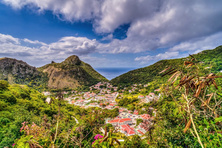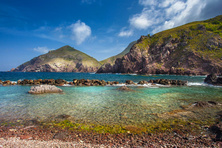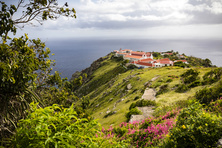Saba
- Currency: US dollar
- Time: UTC-4
- Languages: Dutch, English (regional)
- Religions: Christianity (Catholicism, Protestantism)
- Sections: Get in Visa Customs Cuisine Money Details of interest Popular resorts
Saba is a Caribbean island and the municipality of the Netherlands. It consists of the islands of Bonaire, Sint Eustatius and Saba. Its nearest neighbors are the St. Eustatius island and Saint Martin island. The capital city is Bottom.
The island has a maritime tropical climate with frequent trade winds. The temperature does not change significantly during the year, so the touristic season lasts all the year round. However, the tourists should be aware that from July to October there is a great risk of hurricanes.
The official language is Dutch but almost all people on the island can speak English. Catholics are in the majority but some people also propagate Protestantism.
Saba is known as the center of diving and ecological tourism. Due to an intricate relief and a rocky coastline, there are no comfortable beaches on the island only some rocky coastal sites. The most convenient place for swimming is the Well’s Bay.
The tourists come to the island, mainly, for scuba diving. There are several dive centers here such as Sea Saba Advanced Dive Center, Saba Divers, and Saba Deep Dive Center. Saba has all you need for windsurfing though this sport is not that popular as diving. Windsurfers usually choose some other islands in this region.
Hiking in the mountains is also arranged for the travelers. This island was formed from the extinct volcano and its major part is covered with thick tropical forest. If you get bored with the underwater activities, explore the hiking trails. The main natural sights of the island are the Scenery Mount and the Ladder Bay. On the island, there are some historical and architectural monuments.
Get in
By Plane
On the island, there is the airport which accepts the flight from Saint Martin island. There are direct flights between the Saint Martin island and North America and Western Europe.
By Sea
There is a ferry route between Saint Martin and Saba. In addition to cruise ships navigating the Caribbean sea and frequently used as a means of transport between the islands, the tourists can take advantage of the motor boats. Some travelers get to Saba by their own or rented yacht.
Visa
The tourists from the European Union and other countries of Western Europe as well as the citizens of Moldova and Balkan states can stay on the Saba for 30 and 90 days visa-free. The period of visa-free stay depends on the agreements between the countries. The tourists with a Schengen visa or having a residence permit of Canada, Ireland, the United States of America or the United Kingdom also do not need to obtain a visa to travel to the Saba.
The tourists from CIS countries who do not fall into any of the aforementioned categories must obtain a Caribbean visa in the Embassy of the Netherlands or a visa center. The documents are submitted only personally.
Usually, the documents for a visa are processed within two or four days but in some cases it can take up to three weeks.
Customs
Import and export of any currency is not restricted but the sum over 10.000 US dollars must be declared.
The tourists can import duty-free the following goods:
- a small amount of alcohol and tobacco;
- perfume;
- personal belongings;
- other goods the total cost of which does not exceed 500 US dollars.
It is prohibited to import:
- leather goods from Haiti;
- Dutch and Suriname silver goods or coins.
The tourists are not allowed to export art objects and items having historical value including the objects found on the sea bottom.
Cuisine
The cuisine of the Saba island has much in common with the cooking traditions of the other Caribbean islands but still it has its own twist due to the influence of the Dutch gastronomic preferences. The staple food is fish and seafood.
As on many other small islands, animal breeding is not widespread and for this reason, meat dishes in the traditional cuisine of the Saba play a secondary role. Of course, in the local restaurants you will find beef, pork, chicken and other meat but it will be traditional European dishes. More or less authentic meat dishes are Cabrito Stob (stewed lamb and goat meat with vegetables), Ayakashi (a meat roll) and Galina (roasted poultry meat).
There is a great variety of soups on the island. We recommend trying iguana soup, Hobie Duchi (cactus soup with pork, fish or shrimps) or Callaloo (a traditional Caribbean soup with taro leaves and stewed meat or fish).
A traditional diet of the local includes a lot of fish and seafood. Treat yourself to a snapper or sea pike roasted over the charcoal, salt cod and baked sea shells, boiled shrimps and fish balls. If you crave for something more exotic, try a banana fish soup Sòpi Kami Piska, a coconut fish soup Sòpi di Piska and cheese pie with beef, fish, spices, raisins and tomatoes Keshi Yen.
On the Saba, you will have to choose from a great variety of fantastic desserts. The most famous are traditional Caribbean Johnny cake, sweet flatbread Pan Bati, a coconut pudding Pudin di Coco, guava and coconut pie and many others.
The locals drink tea, coffee and fruit juices.
Alcohol drinks of good quality are usually imported from other countries. On the island, they produce their own beer. The tourists can also by home-made rum and liqueurs.
Money
The official currency on the island is US dollar which is equal to 100 cents. The bank notes from 1 to 100 dollars and 1 cent and 1 dollar coins are in circulation. As US dollar is one of the most converted world currencies, one can by them beforehand. On the Saba, you can exchange currency at banks.
Credit cards are not widely accepted. One can pay with them only in touristic areas but you can withdraw the money or cash traveler’s checks at banks. There are also many ATMs on the island.
It is better to get traveler’s checks in US dollars. The tourists should be aware that they may have problems paying with large denomination currency as the sellers can have no change.
Details of interest
Sightseeing in Saba
On the territory of the island there are no UNESCO sites however, the entire island is UNESCO candidate. Saba has a unique natural ecosystem which was formed in isolation from all the other Caribbean islands. The natural diversity is complemented by the unique man-made landscape.
The cultural heritage includes four key elements:
- archaeological remnants of the pre-Columbian Indian villages and early European settlements;
- traditional villages with specific architecture and layout planning;
- mansions of Saba with family cemeteries;
- infrastructure of the island with hiking trails, stairs and public reservoirs.
On the island, there are several sights which are of great touristic interest:
- The Saba National Marine Park is an underwater reserve which surrounds the entire island. The best place for diving is Tent Reef Wall.
- The Scenery Mount is the highest peak of the island and all the Dutch Caribbean. The extinct volcano is covered with rain forest and there are some hiking trails there.
- The Dutch Museum Saba and the Harry Johnson Museum. These two museums contain a lot of information and historical artifacts about the past of the island since the pre-Columbian period.
- The Tide Pools at Flat Point. They consist of numerous rock pools of different sizes, wedged between the ocean and a cliff face. This is a habitat for many sea animals.
- Juancho E. Yrausquin Airport is the only airport on the island. It has one of the shortest commercial runways in the world, only 400 m long. Flanked on one side by high hills, with cliffs that drop into the sea at both ends, the airport is considered to be one of the most difficult and dangerous airports in the world.
Souvenirs on the Saba
- hand-made crafts;
- local beer and rum;
- stamps.









